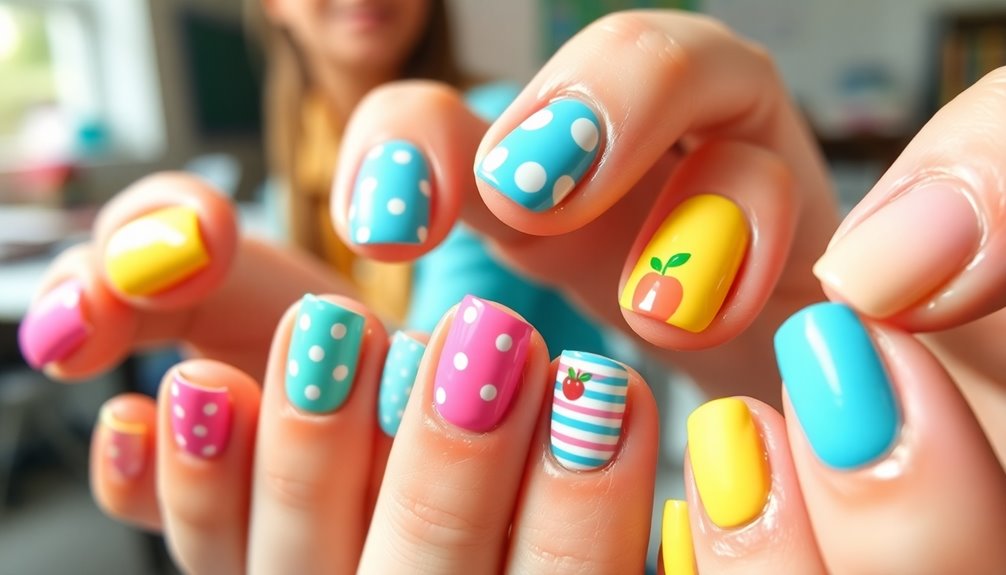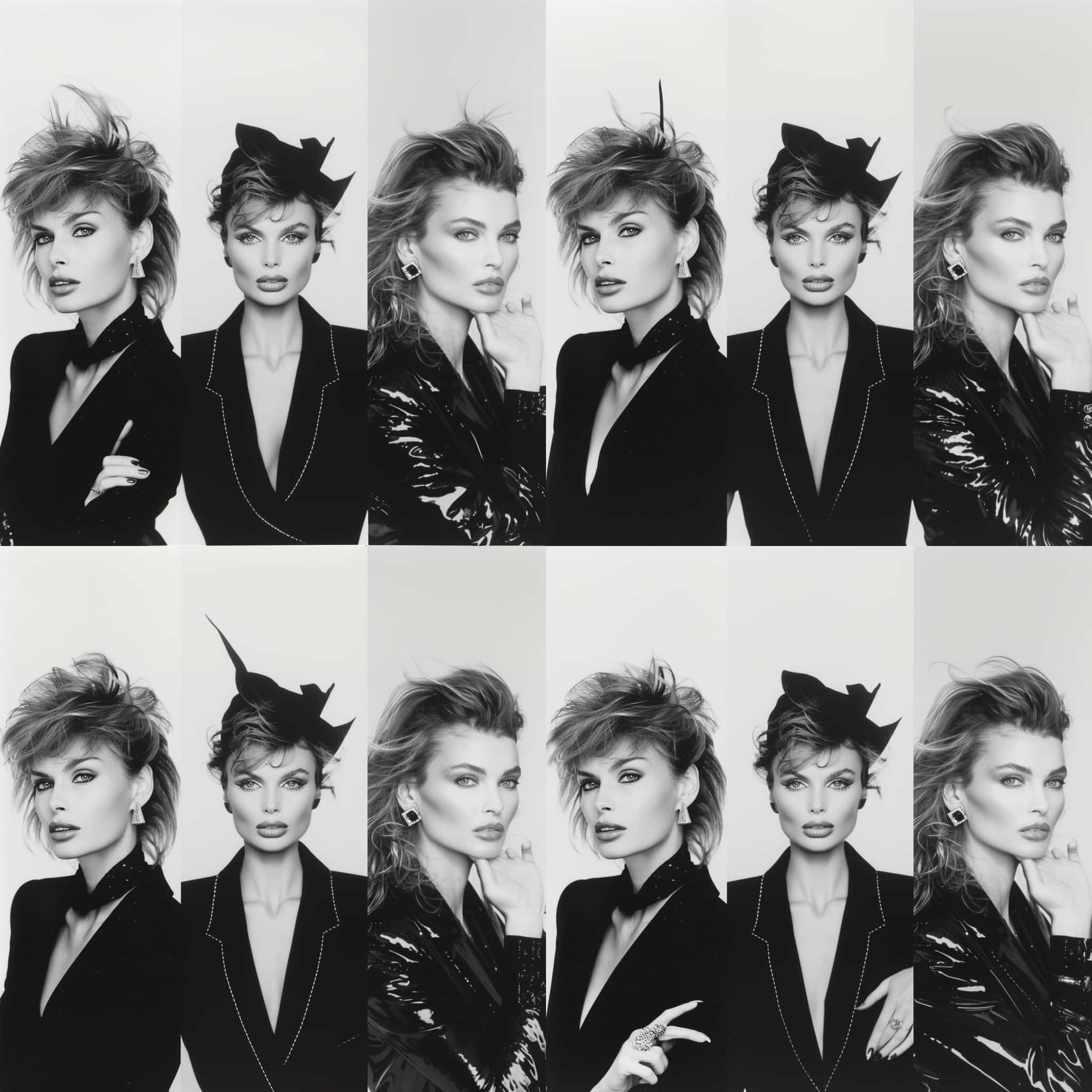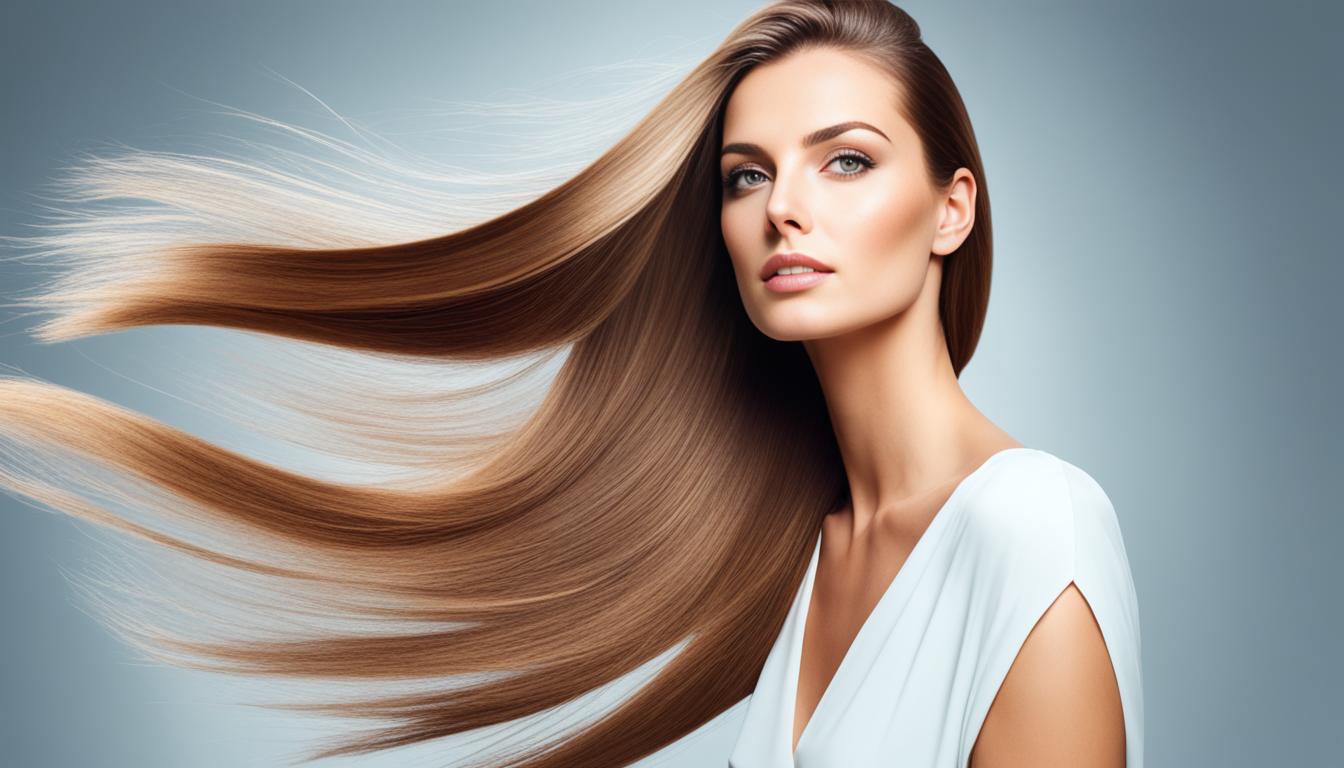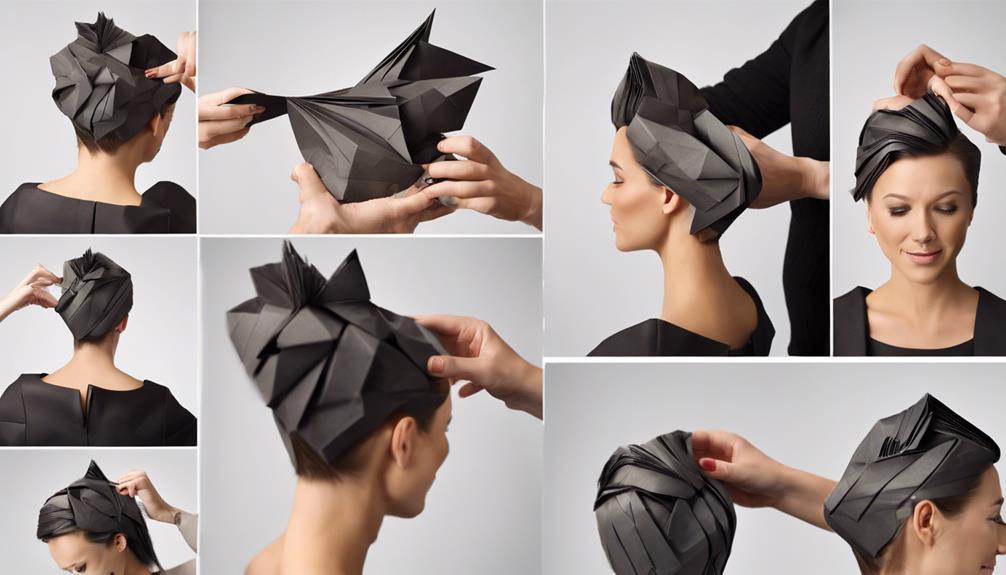To identify your hair type and texture, start by washing your hair with sulfate-free shampoo to remove buildup. Air-dry your hair without products; this allows you to see its natural state. Compare what you see to hair type charts that categorize hair into straight, wavy, curly, and coily. Assess your hair's texture by feeling the individual strands; recognize if they're fine, medium, or coarse. Check your hair's density by measuring your ponytail circumference. Regular evaluations will help you choose the right products and tailor your hair care routine. Stick around to explore more tips and insights!
Key Takeaways
- Wash your hair with sulfate-free shampoo, then air-dry without products to observe natural texture for accurate identification.
- Compare your dried hair with hair type charts to classify it into straight, wavy, curly, or coily categories.
- Assess individual strand thickness using the finger and thumb test to determine if your hair is fine, medium, or coarse.
- Measure ponytail circumference to evaluate hair density as low, medium, or high, impacting volume and styling options.
- Conduct a float test to check hair porosity, determining its ability to absorb and retain moisture effectively.
Understanding Hair Types and Textures

Understanding your hair type and texture is essential for maintaining healthy locks and achieving your desired style. Hair types are categorized into four main types: straight hair (Type 1), wavy hair (Type 2), curly hair (Type 3), and coily hair (Type 4). Each type has unique characteristics that affect how you should care for it.
To identify your hair type, observe how your hair naturally falls when it's wet and unstyled. With the rise in popularity of natural and organic hair products, many consumers are seeking tailored solutions that cater to their specific hair needs, such as those found in the growing hair care market.
Hair texture refers to the width of individual strands, which can be fine, medium, or coarse. This impacts how your hair behaves and responds to products. Additionally, hair density—how many strands you have per square inch—can be low, medium, or high, influencing your hair's volume and styling options.
Regularly evaluating these factors helps you tailor your hair care routine for best results. Consider your hair's porosity as well; it affects how well your hair absorbs and retains moisture.
Key Terminology Explained
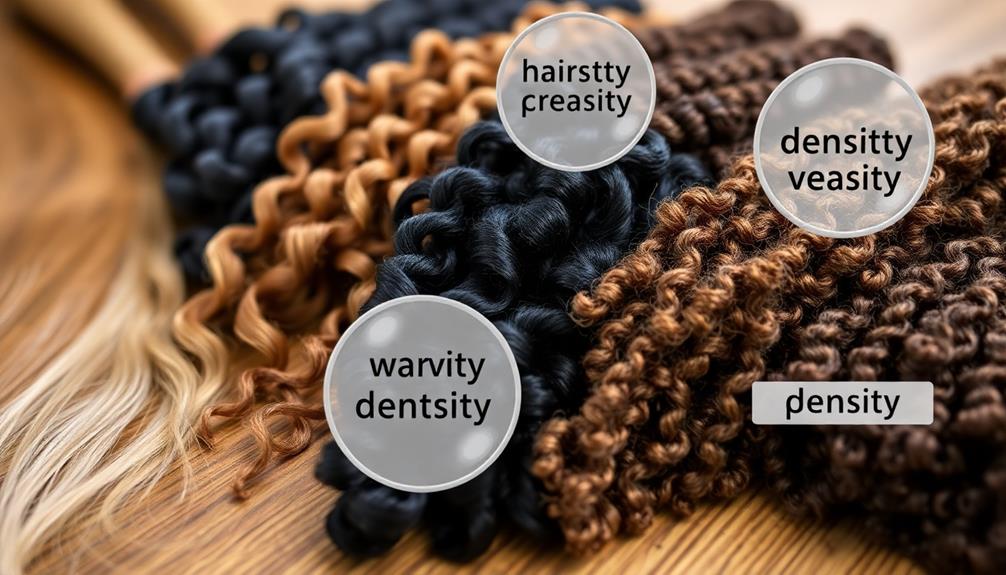
To truly understand your hair, you need to grasp some key terms like hair cuticle and follicle, density, and porosity.
These concepts play an essential role in how your hair behaves and how it responds to care products.
For instance, knowing your hair's porosity can help you select the right essential oils for health conditions that complement your hair care routine.
Hair Cuticle and Follicle
At the heart of your hair's identity lies the cuticle and follicle, two essential components that shape its appearance and texture. Understanding these elements can help you care for your hair effectively.
For instance, just as turmeric is known for its ability to soothe inflammation, understanding your hair's structure can help you choose the right products that prevent damage and promote health natural pain relief properties.
1. Hair Cuticle: The cuticle is the outermost layer of each hair strand, made up of overlapping scales. This protective layer influences your hair's shine and smoothness.
Cuticles vary in porosity; high porosity cuticles absorb moisture quickly but can lead to frizz, while low porosity cuticles resist moisture, often needing specific products to penetrate.
2. Hair Follicle: The follicle is the tube-like structure in your scalp from which hair grows. Its shape determines your hair's texture—round follicles produce straight hair, while oval or flattened ones create wavy or curly hair.
3. Sebaceous Gland: Each hair follicle contains a sebaceous gland that produces sebum, a natural oil that helps moisturize and protect both your hair and scalp.
Understanding Hair Density
Knowing your hair's density is just as important as understanding its cuticle and follicle structure. Hair density refers to the number of individual strands per square inch on your scalp and is categorized into low, medium, and high density.
If you have low-density hair, your ponytail circumference is likely less than 2 inches, which means more visible scalp and fewer strands. Medium-density hair falls between 2 to 3 inches in ponytail circumference, providing a balanced look with moderate thickness. On the other hand, high-density hair boasts a ponytail circumference of 4 inches or more, resulting in a fuller appearance with little to no scalp visibility.
Regular maintenance, akin to replacing filters in air purifiers, can help guarantee your hair remains healthy and vibrant, regardless of density.
Regularly evaluating your hair density can help you track changes over time. This insight allows you to adjust your hair care routines for ideal hair health.
For instance, if you notice your hair density decreasing, you might want to incorporate more nourishing products or treatments. Understanding your hair density not only aids in choosing the right styles and products but also helps maintain overall hair health by addressing specific needs.
Porosity and Moisture Retention
Understanding your hair's porosity is vital for effective moisture retention and care. Hair porosity refers to how well your hair can absorb and retain moisture, categorized into three levels: low, medium, and high porosity.
Knowing your hair's porosity helps you choose suitable hair care products that can effectively penetrate and hydrate your strands. Additionally, just as the importance of self-acceptance plays a role in the journey to wellness, recognizing your hair's unique characteristics can empower you to embrace your natural beauty.
Here's how the different porosity levels work:
- Low Porosity: Tightly closed cuticles make it hard for moisture to penetrate. Use light, penetrating oils and avoid heavy creams.
- Medium Porosity: Slightly open cuticles allow for balanced moisture absorption. Most hair care products work well with this porosity type.
- High Porosity: Wide open cuticles absorb moisture quickly but lose it just as fast. Opt for heavier creams and sealants to retain hydration.
To determine your hair porosity, try the float test: If a strand of hair sinks quickly, it's likely high porosity; if it floats for a while, it's low porosity.
Understanding your hair porosity is essential to maintaining ideal moisture retention for healthy, beautiful hair.
Methods for Identifying Hair Type

To identify your hair type, start by washing your hair and letting it air-dry without any products. This allows you to see its natural texture and can help you better understand its unique characteristics.
Once it's dry, compare your natural texture to a hair type chart that classifies hair into straight, wavy, curly, and coily categories. You can also use the finger and thumb test to assess your hair's texture by feeling individual strands.
Additionally, consider how your hair responds to different environments, such as humidity, which can affect its behavior, similar to how certain foods like celery juice can impact health beneficial for overall health.
Wash and Air-Dry
When you're ready to identify your hair type, start by washing it with a sulfate-free shampoo and letting it air-dry without any products. This method reveals your hair in its natural state, allowing you to observe its true behavior. Here's how to proceed:
- Wash your hair: Use a sulfate-free shampoo to remove any buildup without stripping natural oils. This is especially important as certain products can impact your hair's health and appearance, so consider using top hair products for men to maintain your hair's integrity.
- Air-dry: Let your hair dry completely without applying oils, gels, or leave-in conditioners. This helps you see your hair's authentic texture and pattern.
- Observe and assess: Once dry, pay attention to how your hair behaves.
Straight hair will have no bends, wavy hair will form loose "S" shapes, curly hair will show defined curls, and coily hair will display tight curls or zigzag patterns.
It's essential to repeat this wash and air-dry process a few times to confirm consistency, as factors like humidity and product use can affect your hair's appearance.
Hair Type Chart
Identifying your hair type can feel overwhelming, but a hair type chart makes it simpler. Start by washing and air-drying your hair without any products. Once it's completely dry, look at the natural shape of your hair and compare it to a hair type chart.
This chart categorizes hair into four main types: straight (Type 1), wavy (Type 2), curly (Type 3), and coily (Type 4). Each type has sub-categories (A, B, C) based on the width of your curls or waves, with A being the widest and C being the tightest. To enhance your styling options, consider experimenting with various glamour makeup and hair styling ideas that complement your hair type.
Next, assess your hair's texture. Feel individual strands between your fingers to determine if you have fine, medium, or coarse hair. Fine hair is thin and delicate, while coarse hair feels thicker and stronger.
Additionally, consider your hair density by checking how many strands you have per square inch on your scalp. You can do this by parting your hair and observing scalp visibility or measuring your ponytail circumference.
Regularly reassessing your hair type and texture is key, as changes can occur due to aging, hormonal shifts, or environmental factors.
Finger and Thumb Test
After you've determined your hair type using the hair type chart, it's time to get hands-on with the finger and thumb test. This simple method helps you assess the thickness of your hair, classifying it as fine, medium, or coarse.
Additionally, understanding your hair type can guide you in choosing the right essential oils for hair growth, such as rosemary oil, which stimulates blood circulation and promotes hair follicle health.
Here's how to do it:
- Select 1-3 strands of hair: Choose a few clean strands without any hair products for the most accurate results.
- Hold the strands between your fingers: Pinch the hair gently between your thumb and finger to feel its thickness.
- Identify hair type:
- Fine hair feels barely noticeable and lacks volume.
- Medium hair offers a balanced thickness and holds styles well.
- Coarse hair feels distinctly thick and is easily identifiable.
Determining Hair Texture

To determine your hair texture, start by examining the diameter of your individual hair strands, as this classification is vital for understanding how to care for your hair. Hair texture is categorized into three main types: fine, medium, and coarse. You can easily assess your hair type using a simple finger and thumb test. When you roll fine hair between your fingers, it feels almost invisible, while coarse hair is distinctly thicker and more substantial.
Understanding your hair type will help you select the right products, similar to how hamster care requires attention to specific needs based on the pet's characteristics.
If you find your hair to be fine, it may have less volume and be prone to oiliness. On the other hand, coarse hair often offers a fuller appearance and tends to be more resilient. Medium hair strikes a balance between the two, providing versatility for styling and being less susceptible to breakage.
Consistency in testing your hair texture will yield accurate results, allowing you to choose the right hair products and develop effective hair care routines tailored to your needs.
Understanding your hair texture is fundamental for maintaining healthy hair and achieving your desired style, so take the time to evaluate your individual hair strands carefully.
Assessing Hair Density
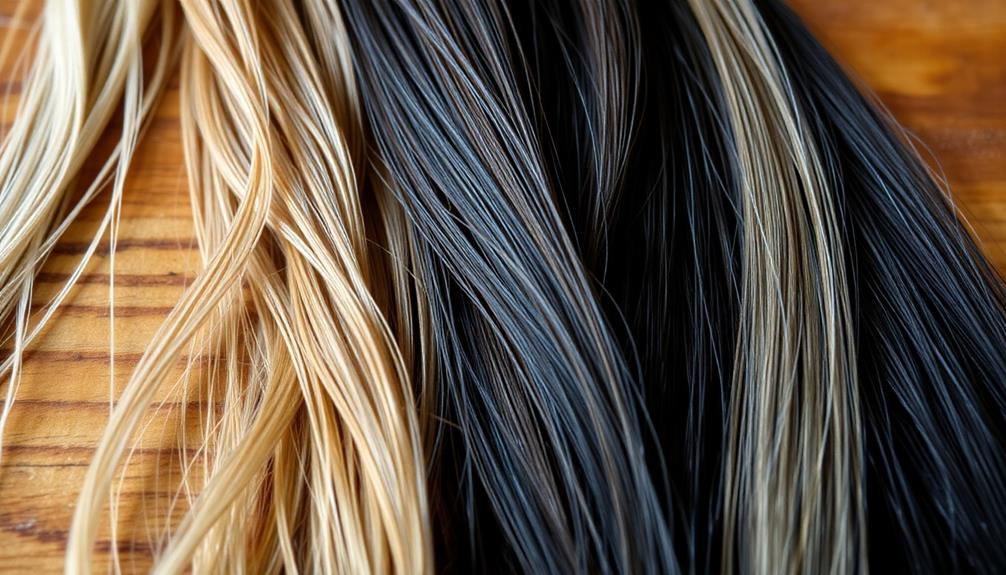
Understanding your hair texture is just the starting point; evaluating hair density is equally important for an all-encompassing hair care routine.
Hair density refers to the number of individual hair strands per square inch on your scalp, and it can be categorized as low, medium, or high density.
Here's how to gauge hair density:
- Part your hair: Create several parts in different areas of your scalp.
- Observe the visibility of your scalp: If you see more scalp, you likely have low density. If your scalp is less visible, you may have medium or high density.
- Measure your ponytail circumference: A ponytail less than 2 inches indicates low density, 2 to 3 inches suggests medium density, and 4 inches or more signifies high density.
Regularly checking your hair density helps you monitor changes over time, which can inform adjustments to your hair care routines.
The average hair density ranges from 80,000 to 120,000 strands.
Hair Care Tips by Type
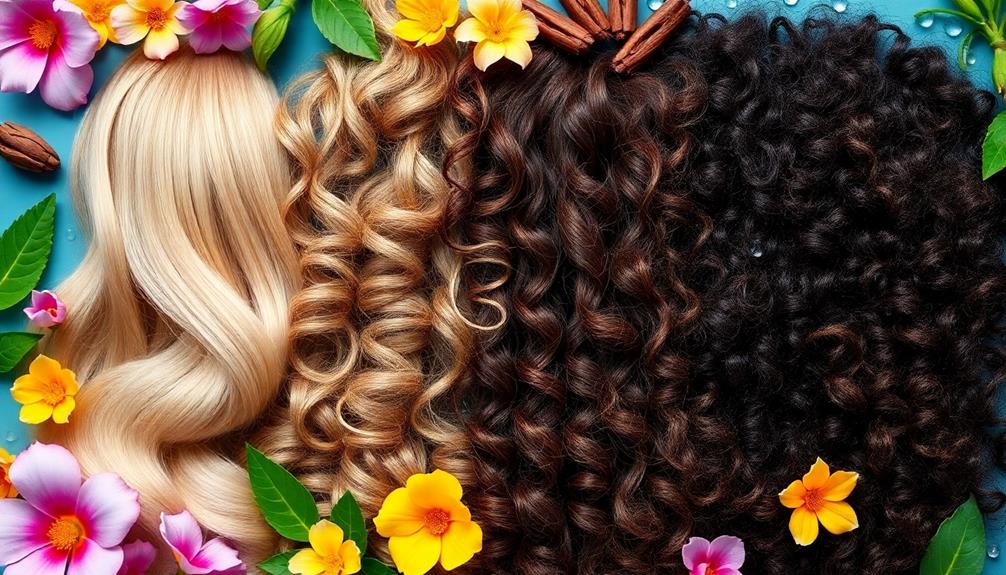
How can you make certain your hair care routine is tailored to your specific hair type? Understanding your hair type is key to selecting the right shampoo and conditioner, styling products, and treatments. Here's a quick guide to help you adapt your care routines effectively:
| Hair Type | Care Tips |
|---|---|
| Type 1 | Wash regularly to manage oiliness; use lightweight styling products. |
| Type 2 | Use moisture-rich products to tame frizz and enhance wave definition; apply heat tools for more defined curls. |
| Type 3 | Focus on hydrating shampoos and conditioners; use curl creams to define curls while reducing breakage. |
| Type 4 | Incorporate deep conditioning treatments; utilize protective styles to retain moisture, especially for 4c hair. |
Regardless of your hair type, always opt for sulfate-free products to enhance moisture retention and promote overall hair health. By following these tailored tips, you'll be on your way to achieving the beautiful, healthy hair you desire!
Seasonal Hair Trends
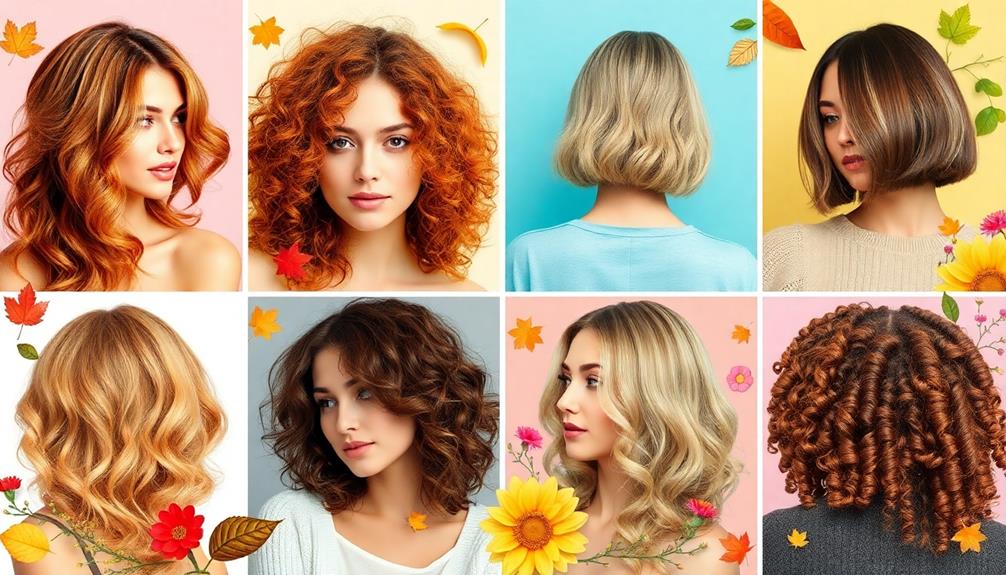
As the seasons change, so do the hairstyles that make a statement. This winter, you can embrace trends that suit your hair type, whether it's curly or wavy. Here are three popular looks to ponder:
- Sleek Ponytails: Perfect for a polished look, this style offers a sophisticated vibe for holiday parties. It keeps your hair out of your face while showcasing healthy hair.
- Soft Waves: Embrace your natural texture with soft, flowing waves. This effortless style highlights your defined curls, making it ideal for casual gatherings.
- Glamorous Curls: If you love a bold look, experiment with defined curls. Using tools from the CLOUD NINE Starlight Collection can help you create festive hairstyles with ease.
Accessorizing with statement hair clips or headbands can elevate any of these styles, adding a touch of elegance to your seasonal style.
Plus, ponder hair treatments that nourish your locks and reduce heat damage while styling your hair. As you adapt your looks for the season, remember to celebrate your unique texture and have fun with bold colors or highlights!
Gift Ideas for Hair Care
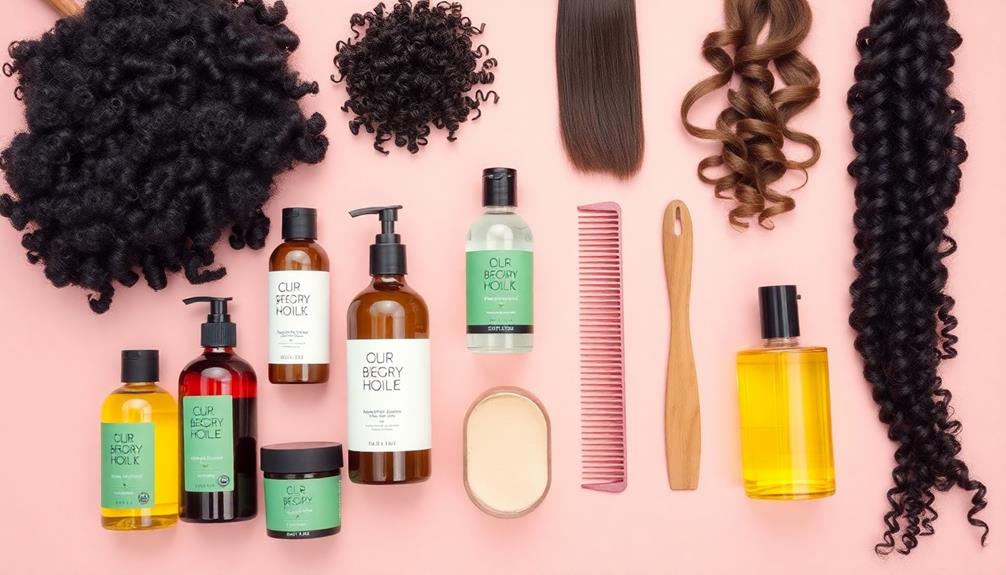
Looking for the perfect gift for a hair care enthusiast? Consider personalized hair care gift sets that include shampoos, conditioners, and treatments tailored to specific hair types. This guarantees your loved ones receive products suited to their unique hair needs.
You might also explore innovative styling tools like high-quality hair dryers and straighteners from reputable brands like CLOUD NINE, designed to minimize heat damage while enhancing styling results.
Gift experiences, too! Salon visits, hair care workshops, or consultations with professional stylists provide personalized advice and treatments, creating memorable moments.
Subscription services are another fantastic option; they deliver curated hair care products based on individual preferences, allowing recipients to continuously explore new solutions.
Don't forget the importance of natural oils or serums that promote hair health and hydration. These essentials are key to maintaining vibrant, healthy hair across all types.
Monitoring Hair Health Over Time
Monitoring your hair health over time is essential for maintaining its importance and appearance. To guarantee your hair remains vibrant, follow these steps:
- Assess your hair type, texture, and density: Wash and air-dry your hair without any products to observe its natural state. Compare this with a hair type chart to identify any changes.
- Track changes in hair health: Regularly check for signs of dryness, breakage, or alterations in density. These indicators may suggest that adjustments in your hair care routine are necessary.
- Log your hair care products: Keep a record of the products you use and their effects on your hair over time. This helps you identify trends and understand what works best for your specific hair type and needs.
Additionally, conduct periodic tests for porosity, like the float test, to measure how well your hair retains moisture.
Don't forget to schedule appointments with a stylist for professional assessments and recommendations. This ongoing monitoring guarantees your scalp and hair remain healthy, allowing you to adapt your hair care strategies effectively.
Frequently Asked Questions
How Do I Know My Hair Texture Type?
To know your hair texture type, grab a few strands and roll them between your fingers. If they feel barely there, it's fine; if thick, it's coarse. Medium strikes a balance between the two.
Is My Hair 2A or 2B or 2C?
To figure out if your hair's 2A, 2B, or 2C, observe the wave definition and texture. If it's loose and fine, it's likely 2A; if frizzier, you might have 2B or 2C.
What Is the Rarest Hair Type?
The rarest hair type is Type 1A, characterized by very straight, fine hair. You might find it requires regular washing and struggles with styling, but its smoothness can be quite unique and beautiful.
Do I Have 1A or 1B Hair?
Your hair's like a canvas; if it lies flat and fine, it's likely 1A. But if it boasts body and holds curls, then you've got 1B. Pay attention to those details!
Conclusion
Now that you know how to identify your hair type and texture, you're equipped to choose the right care products for your unique strands. Did you know that 60% of people don't know their hair type? By understanding yours, you can transform your hair care routine and achieve healthier, more vibrant hair. Remember, taking the time to assess your hair's needs is the first step toward revealing its full potential. Happy hair care!

